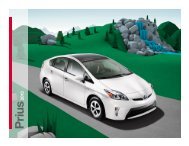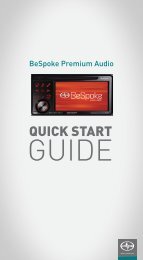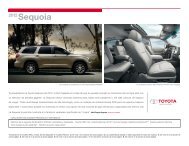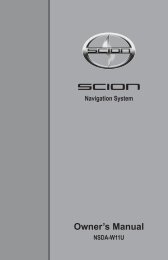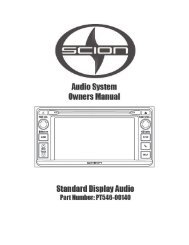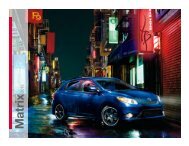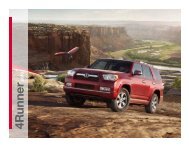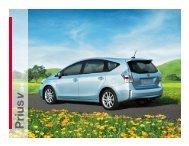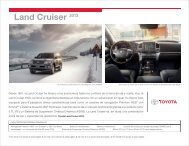Create successful ePaper yourself
Turn your PDF publications into a flip-book with our unique Google optimized e-Paper software.
Engineered to help you<br />
breathe easy.<br />
Enhanced Vehicle Stability Control (VSC)<br />
To compensate for a loss of traction while cornering and help prevent<br />
sideways slipping, <strong>Prius</strong> v utilizes Enhanced VSC. The system adjusts engine<br />
power, braking and steering-assist torque to help the vehicle follow the<br />
direction in which it is being steered.<br />
Traction Control (TRAC)<br />
By slightly applying the brake on a slipping drive wheel and reducing the<br />
throttle, TRAC helps reduce wheelspin and maintain traction, according<br />
to road surface conditions. The system helps ensure vehicle control when<br />
starting or accelerating on slippery roads.<br />
Anti-lock Brake System (ABS)<br />
To help avoid wheel lockup and maintain steering control, <strong>Prius</strong> v uses a<br />
sophisticated computer-controlled system that modulates brake pressure<br />
during hard braking or when braking on a slippery surface.<br />
Every <strong>2013</strong> <strong>Prius</strong> v comes standard with the Star Safety System, a suite of safety features<br />
designed to help keep drivers out of harm’s way. The system includes Enhanced Vehicle<br />
Stability Control (VSC), 1 Traction Control (TRAC), Anti-lock Brake System (ABS), Electronic<br />
Brake-force Distribution (EBD), Brake Assist (BA) 2 and Smart Stop Technology (SST). 3<br />
Electronic Brake-force Distribution (EBD)<br />
Electronic Brake-force Distribution (EBD) helps keep the vehicle more even and balanced when braking. If you have to stop<br />
abruptly, momentum causes the vehicle to tilt forward and reduces the braking effectiveness of the rear tires. EBD responds<br />
to sudden stops by redistributing brake force. Wheels with more braking effectiveness receive more brake force; wheels<br />
with less effectiveness receive less brake force. This helps prevent brake lockup. EBD is especially helpful when carrying<br />
cargo. Sensors recognize the extra load the cargo puts on the rear axle, so brake pressure on the rear wheels is increased<br />
because the extra weight improves braking effectiveness.<br />
Brake Assist (BA)<br />
By measuring the speed and force with which the brake pedal is pushed, BA is designed to detect whether the driver<br />
is attempting a panic stop. If so, it applies additional brake pressure, helping the driver take full advantage of the ABS.<br />
When the driver eases up on the brake pedal, the system reduces the amount of assistance it provides.<br />
Smart Stop Technology (SST)<br />
At speeds greater than five miles per hour, when the accelerator is depressed first and the brakes are then applied firmly<br />
for longer than one-half second, Smart Stop Technology is designed to help the driver bring the vehicle to a stop.<br />
1. See footnote 18 in Disclosures section. 2. See footnote 19 in Disclosures section. 3. See footnote 20 in Disclosures section.



